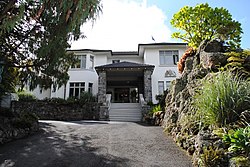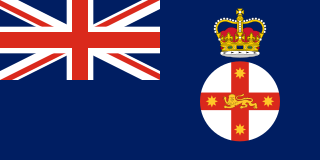
The governor of New South Wales is the viceregal representative of the Australian monarch, King Charles III, in the state of New South Wales. In an analogous way to the governor-general of Australia at the national level, the governors of the Australian states perform constitutional and ceremonial functions at the state level. The governor is appointed by the king on the advice of the premier of New South Wales, and serves in office for an unfixed period of time—known as serving At His Majesty's pleasure—though five years is the general standard of office term. The current governor is retired jurist Margaret Beazley, who succeeded David Hurley on 2 May 2019.

George Eden, 1st Earl of Auckland, was an English Whig politician and colonial administrator. He was thrice First Lord of the Admiralty and also served as Governor-General of India between 1836 and 1842. The province of Auckland, which includes the present regions of Northland, Auckland, Waikato, Bay of Plenty and Gisborne along with the city of Auckland, in New Zealand, was named after him.
Government House is the name of many of the official residences of governors-general, governors and lieutenant-governors in the Commonwealth and the remaining colonies of the British Empire. The name is also used in some other countries.
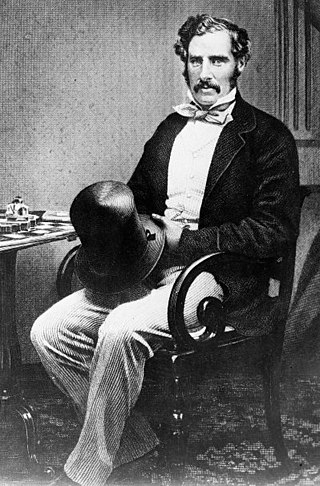
Sir George Grey, KCB was a British soldier, explorer, colonial administrator and writer. He served in a succession of governing positions: Governor of South Australia, twice Governor of New Zealand, Governor of Cape Colony, and the 11th premier of New Zealand. He played a key role in the colonisation of New Zealand, and both the purchase and annexation of Māori land.

Rideau Hall is the official residence in Ottawa of both the Canadian monarch and their representative, the governor general of Canada. It stands in Canada's capital on a 36-hectare (88-acre) estate at 1 Sussex Drive, with the main building consisting of approximately 175 rooms across 9,500 square metres (102,000 sq ft), and 27 outbuildings around the grounds. Rideau Hall's site lies outside the centre of Ottawa. It is one of two official royal residences maintained by the federal Crown, the other being the Citadelle of Quebec.

The monarchy of New Zealand is the constitutional system of government in which a hereditary monarch is the sovereign and head of state of New Zealand. The current monarch, King Charles III, acceded to the throne following the death of his mother, Queen Elizabeth II, on 8 September 2022 in the United Kingdom. The King's elder son, William, Prince of Wales, is the heir apparent.
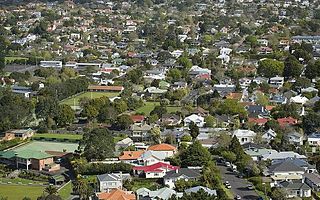
Epsom is a suburb of Auckland, New Zealand. It is located in the centre of the Auckland isthmus between Mount Eden and Greenlane, south of Newmarket, and five km south of Auckland CBD.

Mount Eden is a suburb in Auckland, New Zealand whose name honours George Eden, 1st Earl of Auckland. It is 4 kilometres (2.5 mi) south of the Central Business District (CBD). Mt Eden Road winds its way around the side of Mount Eden Domain and continues to weave back and forth as it descends into the valley; it runs south from Eden Terrace to Three Kings. Mt Eden village centre is located roughly between Valley Road and Grange Road. The domain is accessible on foot from many of the surrounding streets, and by vehicle from Mt Eden Road. The central focus of the suburb is Maungawhau / Mount Eden, a dormant volcano whose summit is the highest natural point on the Auckland isthmus.

Mount Albert is an inner suburb of Auckland, New Zealand, which is centred on Ōwairaka / Mount Albert, a local volcanic peak which dominates the landscape. In the past Mt. Albert also referred to the 2,500 acre borough that was created in 1911 on the outskirts of Auckland City. Mt. Albert was also one of the original five wards within the Mt. Albert Borough. The suburb is located seven kilometres to the southwest of the Central Business District (CBD).

Sir Paul Alfred Reeves, was a New Zealand clergyman and civil servant, serving as Archbishop and Primate of New Zealand from 1980 to 1985 and 15th Governor-General of New Zealand from 20 November 1985 to 20 November 1990. He was the first governor-general of Māori descent. He also served as the third Chancellor of Auckland University of Technology, from 2005 until his death.

Grafton is a suburb of Auckland, New Zealand. The suburb is named for the Duke of Grafton, a patron of the first Governor of New Zealand, William Hobson, and the grandfather of a subsequent Governor, Robert FitzRoy. Once known as 'Grafton Heights', denoting its history as a well-off suburb in Auckland's earliest decades.

Government House, Wellington, is the principal residence of the governor-general of New Zealand, the representative of the New Zealand head of state, King Charles III. Dame Cindy Kiro, who has been Governor-General since October 2021, currently resides there with her spouse, Richard Davies. The present building, the third Government House in Wellington, was completed in 1910, and is located in the suburb of Newtown.

Sir Anand Satyanand, is a former lawyer, judge and ombudsman who served as the 19th Governor-General of New Zealand from 2006 to 2011.
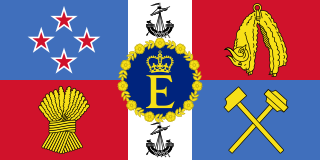
The Queen's Personal New Zealand Flag was the personal flag of Queen Elizabeth II in her role as Queen of New Zealand. It was approved for use in 1962, and was used by the Queen when she was in New Zealand. The Queen’s Representative, the Governor-General of New Zealand, used a separate flag.

The flag of the governor-general of New Zealand is an official flag of New Zealand and is flown continuously on buildings and other locations when a governor-general is present. The flag in its present form was adopted in 2008 and is a blue field with the shield of the New Zealand coat of arms royally crowned. The official heraldic description is "A flag of a blue field thereon the Arms of New Zealand ensigned by the Royal Crown all proper".

Old Government House is the former residence of the Governor of New Zealand in Auckland, New Zealand.
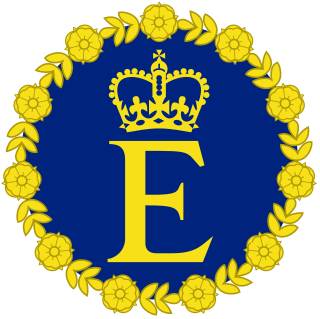
Queen Elizabeth II had a variety of flags to represent her personally and as head of state of several independent nations around the world. They were usually used on any building, ship, car, or aircraft where she was present.

Kinder House and Ewelme Cottage are two historic houses on Ayr Street, in the suburb of Parnell, Auckland, New Zealand.
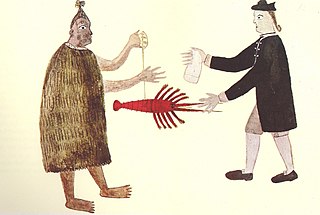
Wellington has been the capital of New Zealand since 1865. New Zealand's first capital city was Old Russell (Okiato) in 1840–41. Auckland was the second capital from 1841 until 1865, when Parliament was permanently moved to Wellington after an argument that persisted for a decade. As the members of parliament could not agree on the location of a more central capital, Wellington was decided on by three Australian commissioners.

The Albert Barracks was a major British military installation that overlooked Auckland, New Zealand, from the mid-1840s to 1870, during the city's early colonial period. The perimeter wall was built between 1846 and the early 1850s, in the area now bounded by Kitchener Street, Waterloo Quadrant, Symonds Street, and Wellesley Street East, according to Colonel Thomas Rawlings Mould's 1860 map of Defensible Works round Auckland. The site is now mostly occupied by Albert Park and the University of Auckland's City Campus, and Princes Street runs through the centre of it. All that remains of the barracks structures is part of the perimeter wall, which is on the university campus.
